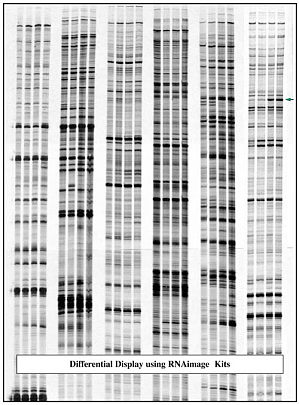结构基因组学
DAY 1PREATMENT01. ___ Mark slides02. ___ 2XSSC 37°C for 30 min (Age slide if necessary)03. ___ 12ul pepsin/40ml 0.01N HCl 37°C for 5 min (Adjust for different conditions)04. ___ 1X PBS 5 min05. ___ 1X ...
All living organisms have thousands to tens of thousands of unique genes encoded in their genome of which only a small fraction perhaps 15% are expressed in any individual cell. Therefore it is the te ...
DNA is dissolved in Hepes buffer (10 mM pH 7.0) at a final concentration of 20mg/ml. Cationic polymers are dissolved in pure water (2.5 mg/ml). An appropriate volume of cationic polymer solution is ad ...
Place 20 mg/ml of DNA (Calf thymus or plasmid) in a polymethacrylate fluorimeter cuvette containing 2 mls of water with 400 ng of ethidium bromide / ml. Place the cuvette was placed in either the Kont ...
Complexes can be isolated from serum by centrifugation on either a sucrose or Percoll gradient. The sucrose gradient is the easier of the two to set up.Sucrose gradient:Place 5 ml of 50% sucrose in ...
Make complexes according to standard protocol Add the nuclease and any co-factors that are required to the complexes. A few units of nuclease should be enough. DNase I micrococcal nuclease and mung be ...
PHK points to bear in mind PHKs must be actively dividing to be successfully infectedPHKs must never become confluent because they become difficult to trypsinize (e.g. even if you do force them all of ...
This method works well for 17.5 day mouse embryos.All stains should be made up fresh.Fix embryos in 90% ethanol for at least 1 week longer if possible. Prior to staining remove skin and viscera partic ...
The number of infertile couples has increased in recent years and is now estimated at 15�20% of all couples worldwide. Since its introduction into reproductive medicine in 1978 in vitro fertilization ...
Sending Sera to Testing for Mouse Pathogens.Bleed mice: Obtain 300-400µl from mice of various ages (older mice that have been in the room for an extended period) and strains (include nude mice if in t ...
Given each mouse 0.05 ml PMSG (Straight from vial) administered i/p at 12 o'clock midday46 - 48 HOURS LATER (i.e. 10am - 12noon two days later)Dilute 0.5ml hCG (in vial) in 2ml PBSOf this mixture give ...
This is the method I use routinely. ProcedureRemove tissue or fetus and fix in fresh 4% paraformaldehye/PBS (pH 7.0-7.5) for 1 hour at 4oC. Rinse three times for thirty minutes each with rinse buffer ...
This is the method I use routinely. ProcedureRemove tissue or fetus and fix in fresh 4% paraformaldehye/PBS (pH 7.0-7.5) for 1 hour at 4oC. Rinse three times for thirty minutes each with rinse buffer ...
Day -3 (Saturday night/early Sunday morning)Thaw out a vial of ES cells (R1 W9.5) and plate on a 6 cm dish which has previously been gelatinised and feeders laid down. Day -1 (Monday)Prepare 10 6 cm d ...
Media UsedTo prepare 100 ml mediumDMEM80 mlFCS15 mlNon-essential amino acids (100x)1 mlPen/strep (5000 1U/ml 5000 ug/ml)1 mlL-Glutamine 200 mM1 mlNucleosides stock (100x)1 mlBME 0.1M0.2 mlDulbecco's M ...
1. Introduction. This is a brief outline of the steps necessary to obtain transgenic mice or transgenic rats. Simply put the investigator constructs a transgene with a promoter and a structural gene ( ...
This is a two step procedure utilizing a Qiagen Large-Construct Kit for the initial purification followed by either a chromatographic separation OR gel purification. Qiagen Prep of BAC DNAModified fro ...
Since most people have their own preferences with this task you are completely at your leisure to ignore this section. This procedure works for me. However be aware that highly purified DNA is importa ...
This protocol was developed by Jan Parker-Thornburg at The Ohio State Universtiy1)Run the DNA digest on an agarose gel: Make a 1% Seaplaque (or other very high quality) Low melt agarose gel using 1X T ...
This protocol was developed by Jan Parker-Thornburg at The Ohio State Universtiy1)Run the DNA digest on an agarose gel: Make a 1% Seaplaque (or other very high quality) Low melt agarose gel using 1X T ...






